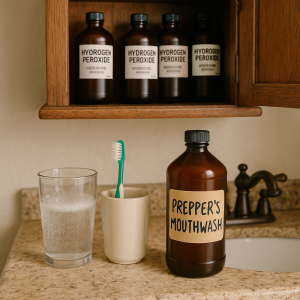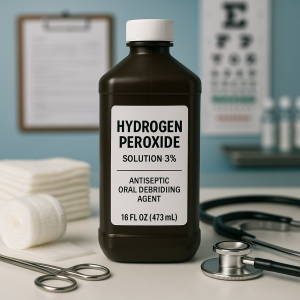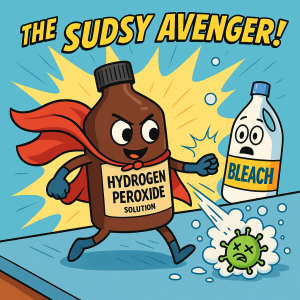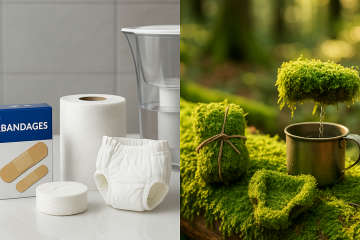
Hydrogen peroxide-a VIP member of your first aid kit
From the moment I took that first fizzy swig—okay, more like a reluctant swish—of diluted hydrogen peroxide for these mouth sores that showed up uninvited like distant cousins at a family reunion, I remembered just how many times this humble brown bottle has come to my rescue. It’s not fancy. It doesn’t sparkle in a commercial. But goodness gracious, it gets things done.
Hydrogen peroxide is like the quirky neighbor with a snowblower in July—you don’t think much of them until the storm hits and suddenly you’re grateful they exist. From cleaning wounds to scrubbing mildew off the grout that’s trying to launch a colony, this stuff shows up, fizzes dramatically, and gets out of the way. And in a world where we prep for everything from power outages to cranky gums, it might just be one of the most underrated MVPs in your arsenal.
1. The Medical Marvel (And Not Just for Boo-Boos)
Most people know hydrogen peroxide as “that stinging stuff Mom used to pour on scraped knees while saying, ‘See? That means it’s working.’” But there’s a lot more going on under that brown bottle cap.
-
Mouth Rinse: When diluted (about 1 part peroxide to 2 parts water), it can ease sore throats, zap canker sores, and make your mouth feel fresher than a peppermint in a snowstorm.
-
Wound Cleaner: Yep, it’ll bubble away bacteria on minor cuts and abrasions. Just don’t overdo it—it can also delay healing if used too frequently on healthy skin tissue.
-
Earwax Softener: Just a few drops can clear things up if your ears are feeling more clogged than a toddler’s nose during cold season.
Note: Don’t swallow it, snort it, or use it as a juice cleanse. That’s not prepping. That’s flirting with Darwinism.
Hydrogen Peroxide in First Aid: Not Just for Dramatic Effect
Let’s talk first aid. Because while hydrogen peroxide might have the flair of a fizzing firework, it’s not just putting on a show for your scraped knee—it’s doing real work under the surface (literally).
Why It Works (a.k.a. What’s With the Bubbles?)
When hydrogen peroxide (H₂O₂) hits your skin and encounters an enzyme called catalase—which lives in blood, damaged cells, and certain bacteria—it rapidly breaks down into water (H₂O) and oxygen (O₂). That bubbling isn’t just for drama; it’s oxygen gas being released, and it’s part of what gives peroxide its cleaning and antimicrobial punch.
-
The oxygen kills anaerobic bacteria, which are the kind that really don’t like air and tend to thrive in dirty wounds. This makes peroxide especially useful for cleaning puncture wounds or injuries where oxygen exposure is low.
-
The bubbling also helps lift debris from wounds—dirt, dead skin, dried blood—making it easier to clean a cut without going in there with a toothbrush and a prayer.
But, word to the wise prepper: hydrogen peroxide doesn’t know the difference between bad bacteria and your good, healing tissue. So if you use it too often or too aggressively, it can actually slow down wound healing. Think of it like a friend who helps you move by throwing out everything, including your tax returns. Helpful…ish.

Hydrogen peroxide for medical uses
First Aid Uses Beyond the Obvious
-
Blister care: Got a popped blister from hiking in boots that were 10% boot and 90% regret? Dab some peroxide on the area to prevent infection before you bandage it up.
-
Nail and cuticle infections: Soak a cotton swab in peroxide and dab it on sore cuticles or minor nail infections to help stop them from becoming a full-blown medieval tale.
-
Bug bites and stings: It can help clean the bite area and reduce bacteria. (But don’t use it on deep punctures like spider or snake bites—get professional help, Indiana Jones.)
-
Toe jam trauma: Ingrown toenails, minor foot fungus, and funky-smelling toes benefit from a soak in a diluted peroxide bath (about 1 part peroxide to 3 parts warm water).
-
Acne & skin infections: For small surface-level pimples or minor skin infections, peroxide can help zap bacteria. But don’t go overboard—unless you’re going for “scaly lizard chic.”
2. The Sanitizer You Didn’t Know You Needed
Hydrogen peroxide isn’t just for humans. It’s a germ-fighting, mold-blasting, surface-sanitizing powerhouse:
-
Toothbrush Disinfector: Dip and swirl your brush in it for a few seconds. Bye-bye, morning breath bacteria.
-
Kitchen Crusader: Great for cleaning cutting boards, sinks, or even produce (just rinse well).
-
Bathroom Avenger: Spray it on shower curtains, tile grout, and any area that might be hosting a moldy mosh pit.
It’s a mild bleach, without the drama and wardrobe-ruining side effects. Use it in a spray bottle for sanitizing surfaces, especially if you don’t want your bathroom smelling like a public pool.
3. Garden Whisperer & Homestead Helper
You didn’t think I’d leave out the homestead uses, did you?
-
Seed Germination Boost: Soak seeds in a peroxide solution to help wake them up like a triple espresso.
-
Plant Fungus Fighter: A diluted mix sprayed on plants can help treat root rot and powdery mildew.
-
Chicken Coop Cleaner: That’s right. Even the cluckers benefit from a little peroxide power when cleaning nesting boxes and feeders.
Hydrogen peroxide is basically the Leatherman tool of liquids. Only cheaper. And less likely to poke a hole in your jeans.
4. Shelf Life: The Dirty Little Secret of the Brown Bottle

Hydrogen peroxide has lots of uses for medical preparedness to household care
Now for the truth bomb: hydrogen peroxide doesn’t last forever.
Here’s the deal:
-
The typical store-bought 3% solution starts to break down the moment it’s opened. That’s why it comes in dark brown bottles—light is not its friend.
-
Once opened, you’ve got about 6 months to a year before it loses much of its fizz and turns into slightly judgmental water.
-
Unopened, it can last up to 5 years, especially if stored in a cool, dark place. (So not your windowsill next to the cat.)
Want to check if it’s still good? Pour a little on a cut or even in the sink. If it fizzes, you’re golden. If it just sits there like a teenager asked to do chores, it’s time to replace it.
Bonus prepper tip: You can buy food-grade hydrogen peroxide (35%), but it must be diluted properly and handled with extreme care—think hazmat suit vibes. It’s powerful stuff but has a longer shelf life when stored correctly and can be diluted into many more uses.
5. Storage Smarts: Because We’re Preppers, Not Hoarders
Hydrogen peroxide likes it:
-
Cool (think basement pantry, not car trunk in July),
-
Dark (brown glass bottles, no sunlight striptease),
-
Closed (seal it tight to keep the magic in).
Pro tip: if you really want to go next-level, consider vacuum-sealing small amounts in UV-proof mylar pouches with date labels for your long-term kits. It’s basically the VIP lounge treatment for peroxide.
Why Hydrogen Peroxide Deserves More Hype
Let’s be real. In a world where people stockpile tactical pens and pineapple slicers like they’re survival gear, hydrogen peroxide is the humble workhorse that actually does something useful. Quietly. Consistently. Without needing batteries or Bluetooth.
So go ahead—next time you’re in your prepper stash, give that little brown bottle a wink. It’s not flashy. It doesn’t scream “zombie apocalypse ready.” But when it comes to being truly prepared, hydrogen peroxide proves that bubbles beat bravado every time.


